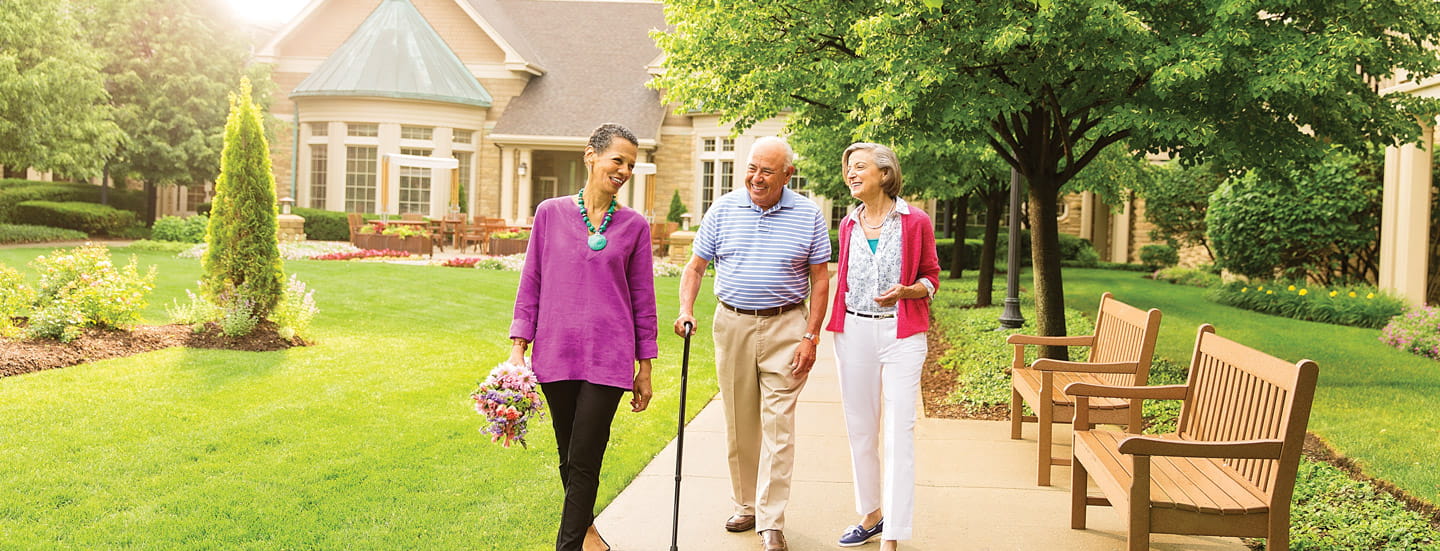Accreditation is one way for prospective residents and their families to weigh their senior living options using objective criteria.
This process measures how a senior living facility stacks up to an established standard. Senior living accreditation is especially prevalent in assisted living. Accreditation bodies in this space include The Joint Commission, CARF International, and Accreditation Commission for Health Care.
While not an official accreditation body, Medicare.gov’s Nursing Home Compare website also offers an objective five-star rating system for patients and their families to evaluate nursing homes, home health services, hospice care, inpatient rehabilitation facilities, long-term care hospitals and more.
ADLs include everyday tasks that seniors in assisted living may need help with, including:
- Walking
- Transferring, including from bed to a chair, or into a wheelchair or walker
- Feeding
- Dressing
- Grooming
- Bathing
- Toileting

Aging in place
Aging in place refers to remaining at home as you get older, rather than moving into a senior living community. More than three quarters of adults 50 and older want to age in place at home for as long as possible, according to an AARP survey.
Is it right for you? Learn about the pros and cons of aging in place versus moving to a senior living community.
Assisted living
This level of care is designed for people who need assistance with activities of daily living, also known as ADLs.Caregivers in assisted living offer support with those activities of daily living as well as medication management. However, most seniors in assisted living remain relatively independent and don’t require around-the-clock medical care (in contrast to skilled nursing care).
Assisted living facilities
In assisted living facilities, seniors receive assistance with activities of daily living (ADLs). Residents have private residences along with access to community spaces like dining rooms, game rooms, fitness centers, salons and more. They receive hands-on care from skilled professionals according to a personalized care plan.Certified nursing assistant (CNA)
These healthcare workers provide personal care to patients, including assistance with activities of daily living (ADLs) and medication management. CNAs, also known as nursing assistants, nurse's aids or patient care assistants, work in a variety of settings, including skilled nursing facilities.
Congregate housing
This is an umbrella term for any residential community where residents have their own private living space but share some communal living spaces, such as dining rooms, recreational and wellness areas, outdoor spaces, and other social gathering places.
Senior living communities are an example of congregate housing.
Continuing Care Retirement Community (CCRC)
In these communities, residents enjoy an independent lifestyle along with access to a care center that offers a comprehensive continuum of care, including assisted living, skilled nursing and memory care.
CCRCs offer three different types of contracts, some of which build care access into monthly fees and offer it on site, while others provide care (or access to off-site care) at market rates.
CCRCs are also sometimes known as Life Plan Communities.
Continuum of care
This term refers to the levels of healthcare services available to senior living residents. In a Continuing Care Retirement Community or Life Plan Community, Independent Living residents have access to all levels of care along the continuum, starting with independent living and including assisted living, skilled nursing and memory care.
Director of nursing (DON)
DONs are ultimately responsible for all nursing care in their facility and will also communicate with residents and their families and physicians as needed. These registered nurses are responsible for supervising the operations and staffing of a nursing unit, including clinical, financial, HR, and quality assurance.
Health Insurance Portability and Accountability Act (HIPAA)
This United States federal statute was signed into law in 1996. Most notably, HIPAA’s Privacy Rule (Article 2) protects patients’ protected health information, including medical records and any data that is considered “individually identifiable.”
This rule also gives individual patients the right to:
- See or get a copy of their health records
- Request copies of their health records be electronically sent to a third party
- Ask for corrections to their health records
Home health care
For seniors who are aging in place at home, home health care providers can offer assistance.
They have a range of skill levels and credentialing, from unlicensed personal care aides who provide non-medical care and companionship to licensed professional nurses (LPNs) and registered nurses who can provide higher-level medical care.
Independent living
In independent living, seniors live on their own with a lower-maintenance lifestyle that allows them to fully enjoy their retirement.
Independent living residents can take advantage of a variety of services and amenities included with their monthly expenses, including home maintenance, chef-prepared meals, and wellness activities.
Licensed practical nurse (LPN)
These healthcare professionals work under the supervision of a physician or registered nurse to monitor patients, administer medications, and ensure a resident’s care plan is carried out properly. Their responsibilities may also include taking vital signs, charting, inserting catheters, providing wound care and more.
Life Plan Community
Another term for Continuing Care Retirement Community.
Living will
If you can’t make decisions for yourself, these written instructions can dictate your medical wishes. They’re also known as advance healthcare directives, personal directives, advance directives, medical directives or advance decisions.
Doctors, caregivers and loved ones will need these documents if you’re terminally ill, in a coma, living with advanced dementia, seriously injured or nearing the end of your life.
Long-term care facility
For those who are no longer able to live on their own, these facilities provide medical and personal care and support. Despite the name, patients don’t always remain in long-term care permanently and can often move back home or into independent living after they recover from an illness, surgery, fall or other malady.
Nursing homes, skilled nursing facilities, and assisted living facilities are examples of long-term care facilities.
According to the Administration for Community Living, an adult turning 65 has a nearly 70% chance of needing some type of long-term care.
Long-term care insurance
These insurance policies defray the costs of care for chronic medical conditions or disabilities.
Long-term care insurance policies may reimburse you for costs associated with home health care and treatment in nursing homes, assisted living facilities and adult day care centers. A policy may also dovetail with the services offered in a Continuing Care Retirement Community.
Memory care
Memory care, also known as memory support, provides comprehensive care for patients diagnosed with more advanced dementia conditions, including Alzheimer’s Disease.
Caregivers in these facilities design custom treatment plans, in partnership with doctors and family members, to manage residents’ cognitive decline and keep them engaged with their lives.
Nursing home
In nursing care facilities, residents receive specialized, highly supervised medical care, either long-term or as they recover from a surgery or illness.
The term is sometimes incorrectly used as a catch-all for senior living communities or standalone assisted living facilities. But in fact, it refers only to communities where residents receive around-the-clock skilled nursing care.
A registered nurse (RN) is a licensed medical professional who can work in a variety of medical and community settings.
RNs work hands-on with patients and alongside doctors and other healthcare professionals.

Residential care homes
Most residential care homes offer care like what assisted living residents receive — but on a smaller scale. These intimate senior living communities are home-like settings that offer personalized care for a small number of residents (think 10 residents as opposed to hundreds).
Sandwich generation
This population is made up of middle-aged adults who are caregivers and/or providers for both their own children and their aging parents.
Senior move manager
Senior move managers help seniors prepare (both physically and emotionally) for a relocation to a senior living community or other facility.
Senior move managers can assist with downsizing, estate sales and auctions, donations, packing and unpacking, the move itself and even creating floor plans for a new residence.
Skilled nursing is around-the-clock, hands-on care that could include physical, occupational and/or speech therapy. In skilled nursing, licensed professionals create and manage care plans that are tailored to each resident’s individual needs.
Seniors might require short-term skilled nursing services for post-surgery recovery or rehabilitation, or they might need longer-term nursing care.

This design approach is focused on creating spaces that are accessible to all people regardless of age, disability, and other factors that traditional design might limit.
Universal design in a residential environment could include no-step entryways, wider doors and hallways, adjustable-height counters, non-slip surfaces and grab bars in bathrooms, lever-style door handles, and more.
Senior living communities that are directly affiliated with a nearby higher-education institution are known as UBRCs. University-based retirement communities are formally tied to the university and encourage lifelong learning as well as interaction between community residents and the general student population. They are an especially powerful draw to university alumni, retired faculty and former employees.
Many are Continuing Care Retirement Communities that offer residents access to the full continuum of care, including independent living, assisted living, skilled nursing and memory care.
This Veterans Administration (VA) pension benefit provides tax-free funds for long-term care services to veterans and their surviving spouses.
In general, the VA does not pay for room and board or basic services in assisted living, but funds from this program can be used to pay any expenses associated with long-term care, including residential expenses in assisted living.
To find out if you qualify, contact the VA.
Glad to be connected!
There’s a lot to consider when embarking on the next phase of retirement—and contacting us is a big step. (Well done!)
We’ll be in touch soon to share expert insights and resident perspectives that we hope are helpful, and one of our team members will also be reaching out to answer any questions you may have.

